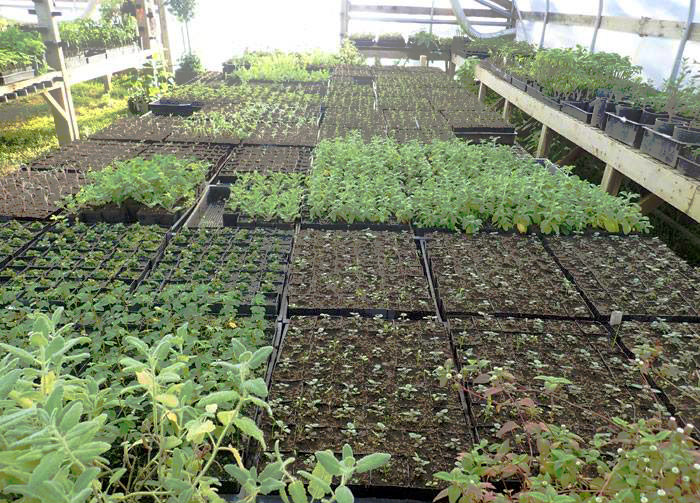
Know your seed. Examine the seed before planting. Large seeds, especially those from the Legume (Fabaceae) family, have impermeable seed-coats that may require scarification (nicking or rubbing) before planting. Smaller seeds in the Lamiacea (the mint family) also appreciate scarification to wake them up — rub on a #8 seed-screen or on medium grit sandpaper. Needle-like seeds in the Asteracea (the aster family) are never scarified. They need a rich potting soil and germinate in warm temperatures. Observing the size and shape of the seed before you plant it will help you identify the seed and differentiate it from impostors when it comes up.
Know your plant. If you understand the native growing conditions for the plant you are working with, this usually translates to an understanding of the proper soil mix for planting the seeds. White Sage (Salvia apiana) is a desert plant, therefore planting in sand and keeping in the strong light much improves the likelihood that the seed will germinate in domestic culture.
Seeds require a sense of place. Seed plantings must be tamped in order to assure that the seeds stays in the original orientation, does not float away when watered, and does not shift over time and waste precious energy in re-orienting its emerging root. This generally means:
- A fast-draining mix (incorporate white pumice and coarse, sharp sand to your potting soil or simply plant in coarse, sharp sand). Use chicken grit (ground sharp stone) purchased at your feed-and-seed or check local quarries. You can provide nutrients later.
- Watering should be done in such a way as to not dislodge the seed. For small seeds, rough-up the surface of the flat, sprinkle the seeds in a well-defined row, label assiduously, tamp (press) the seeds down into the mix, and water sparingly at first. The matrix will swell around the seed and hold it in place. Water again to be sure the seeds have enough moisture to imbibe and germ. Water again only after the surface begins to dry. Do not float the seeds with excessive watering.
Damping-off. Understand that seeds will germinate and then keel over if they are watered too often, especially if temperatures are cool, but sometimes also in warm flats. Thin seedlings to a reasonable distance to promote their health and provide resistance to pathogens (e.g. phytophthora).
Even warmth vs. oscillating temps. Most garden annuals (e.g. tomatoes and peppers) are going to do best in a rich mix with warm temps (~70 degrees F). Lettuce will not germinate if temperatures reach 80 degrees F. Many permaculture trees and herbaceous perennials will do best in a cold greenhouse where the temperatures are cold at night and warm during the day. Outdoor treatment is another good way to assure temperature oscillation. For example, with Aconite, Hawthorn, Elderberry or Spikenard, set the flat of seeds in the shadehouse in the fall or early spring and allow the large cycle (winter to spring) and short-cycle (night to day) to work on the seeds until they finally germinate. Hawthorn seeds germinate after 12 months whether planted in the spring or in the fall.
Grow-lights and heat mats. In nature, heat comes from above (the sun) and not below, so it is better to provide even warmth from a grow light (above) than to cook the roots with a heat mat. 8-bulb T-5 grow lights are standard equipment, and they are sweet! Best to place the grow lights in the greenhouse and turn them on and off according to the light cycles of the season. 3-day germination on white sage (Salvia apiana) is typical when the seed is planted in a deep flat of course, sharp sand and oriented 12 inches below the T-5 grow lights. Grow lights in the greenhouse help assure better survival rates of seedlings taken from artificial light into natural light. This transition is always tricky! However, grow-lights don’t work very well for growing-on larger plants. Use the grow-light to germinate the seeds, then transplant the seedlings to individual pots and keep in the greenhouse in preparation to planting outdoors. Time your plantings accordingly.
What not to do. Do not try to soak small seeds in water before planting. They don’t need it, and you will find that wet seeds are clumpy and hard to space in the row. They will imbibe their own water in due time! Do not plant seeds in peat pots unless the plant normally grows in peat (e.g. Heather, Calluna vulgaris). Do not plant seeds between layers of paper towels unless the plant normally grows in paper towels (e.g. none). Do not plant seeds in the basement or other dark areas. Plant them where they can get natural light, even just a little bit of sun.
Hold the Tulsi seed in the light before planting, and take a moment to dedicate your actions to the benefit of all beings, then plant the seeds and–let go. Planters derive great benefit from interacting with the life force. What happens next is between the seed and nature.
For more information on species-specific seed planting, see the Strictly Medicinal Seed Catalogue, our website at www. strictlymedicinalseeds.com, and the book Growing Plant Medicine by Richo Cech.

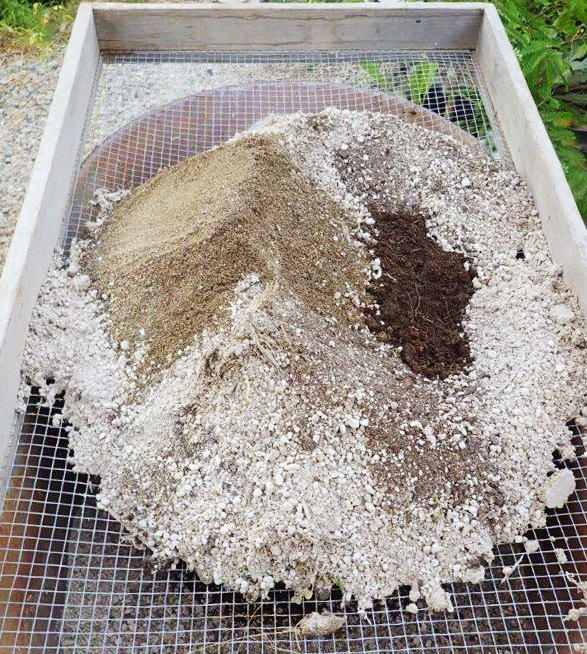
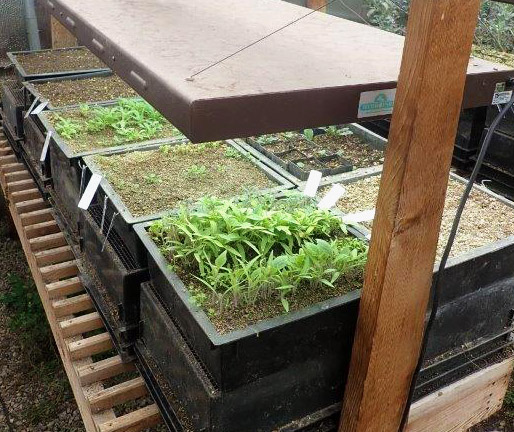
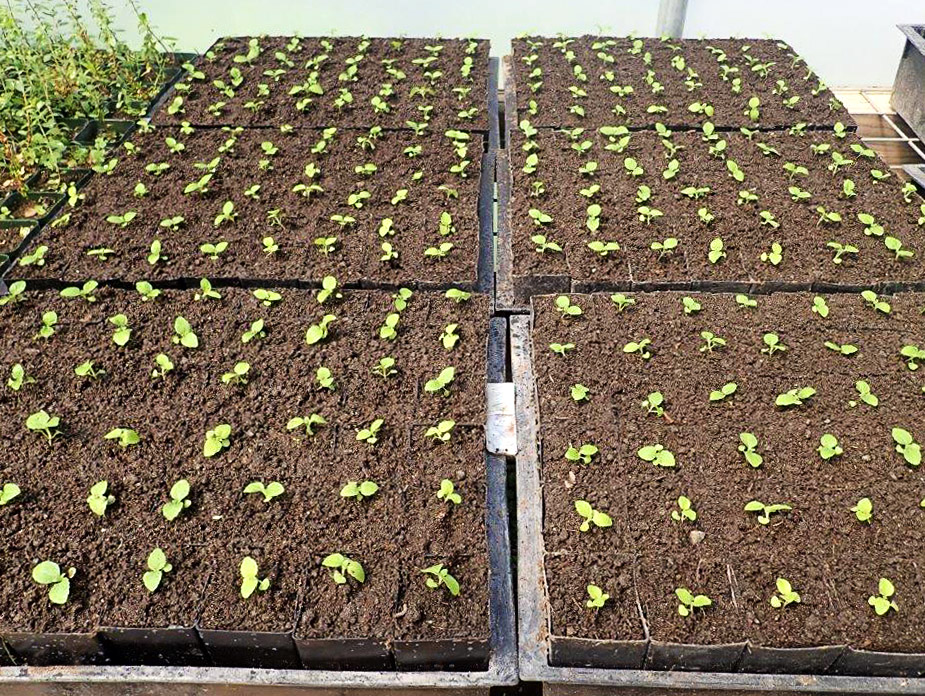
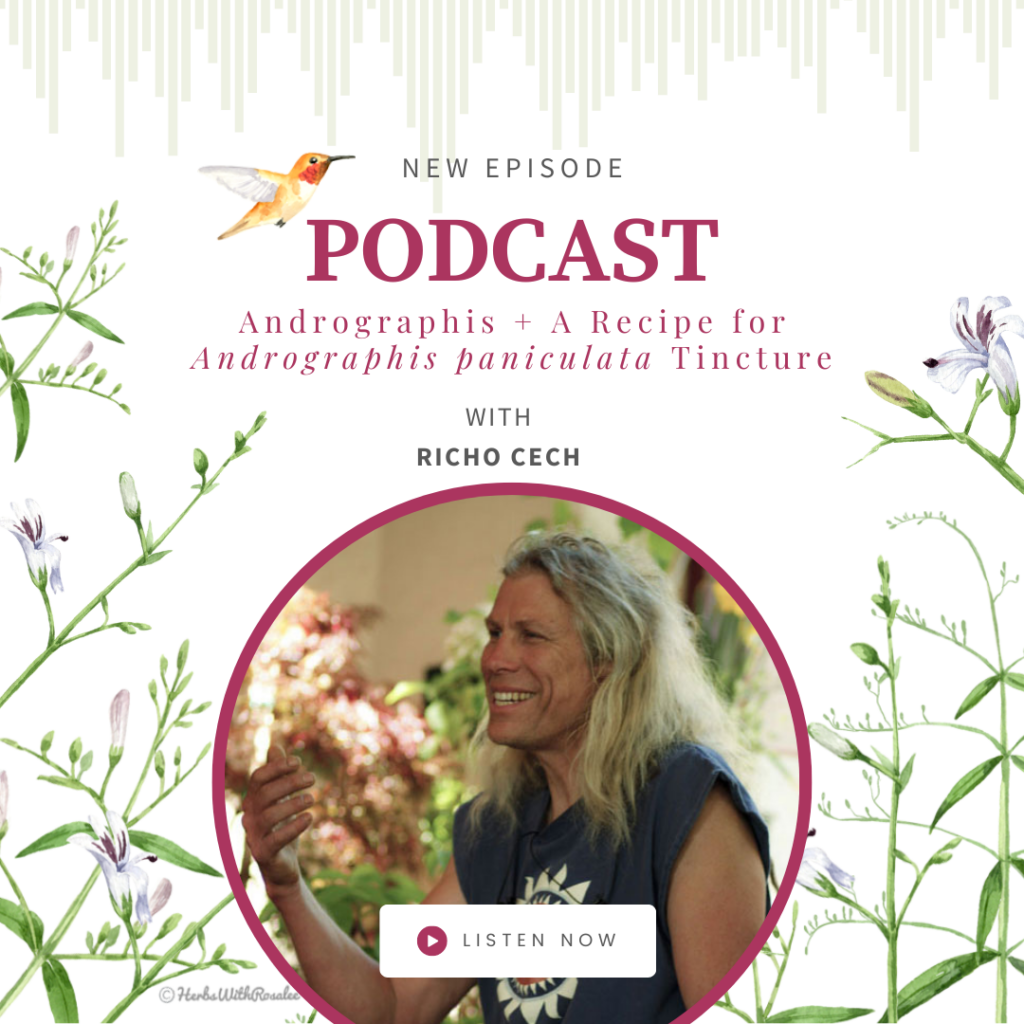
Great article. I will try this with the wild lettuce we have around here. I have a question for you, since you seem to be very knowledgeable here.
Why does Tanacetum Vulgare (Garden Tansy) and Tanacetum Bipinnatum (Dune tansy) Seeds never germinate?
I have ensured that they were properly cold stratified and planted them outdoors, the common variety on a hill in sunshine and the Dune Tansy seeds were planted in somewhat sandy soil by a lakeshore. I want to figure out what I did wrong so that I can try again in the Spring. I can easily collect the common tansy seeds here and the Dune Tansy, whch is more rare, I kept several seedheads. Should I try to germinate them indoors in early spring? I didnt want to since these kinds of plants seem to always show transplant shock no matter how many of the roots you safe (even if you save all of them).
Thanks
hi Mike, Sounds like the seeds probably were not kept moist enough after planting. They need to be evenly moist, and numerous waterings also leaches germination inhibiting compounds from them–use more control and sow seeds in a deep flat instead of trying to jump-start it in habitat–more control, yes. r
Oh Richo, I am so sad. I tried to plant hibiscus sabdariffa and there is not a trace of germination. It’s been 12 days. Should I give up hope?
The Hibiscus must be nicked before planting otherwise dig them up and nick them and replant. If nicked, and give standard horticultural approach, barely covered, tamped, kept evenly moist and warm, then good results may be expected. These are about as easy as a seed gets.
I nicked. I soaked. I tamped. I put under lights. I got nothing.
https://strictlymedicinalseeds.com/product/hibiscus-hibiscus-sabdariffa-seeds-organic
OK, I ran the hibiscus seed for another test and germ occurred in 3 days. above URL will take you to a photo of same. maybe skip the soaking. r
Hello! I love buying from you because you really love what you do! How you keep pests away from your gardens/fields? What fertilizers do you use besides compost? Thank you very much
Hello Andre, Thanks, and I do get a measure of vicarious pleasure when sending seeds to good gardeners. The majority of my growing system is laid out in my book “The Medicinal Herb Grower” which I do recommend. I screen my flats against birds. In the field, mixed plantings are good for relieving pest pressure, and tulsi is an incredible companion plant in that way. As an organically certified grower, if I wanted to use something besides covercrops and compost it would probably not be allowed. Most medicinal herbs don’t require much fertilizer, they grow best in unamended soils, even rocky soils, and I have lots of rocks.
Richo
Loved your article, and referred to it on my blog. Hope you get some visits! Thanks!
https://beesandbloomsfarmette.wordpress.com/2019/03/15/really-great-article-about-seedlings/
Hi, I have 2 year old morning seeds. What’s the best way to germinate them??
Hi there, if its morning glory you’re talking about, nick the seed and plant it in the ground in the spring. Morning glory seeds last for years. richo
I meant ‘MORINGA’ seeds lol sorry about that!
Hi! Moringa is one of the “fatty” tropical seeds that only last a year or so, I would get new ones, not try old ones. r
Hey,I have an ashitaba baby I’m trying not to kill,it’s in a pot at the moment, and it’s been cold overcast and windy where I am,little guy ain’t doing so good,I don’t have a greenhouse,I have a bathroom and a front porch,I think it’s not getting enough light at the moment,I’ve been giving it enough water,I think but it’s not thriving,my cats may have something to do with that,any ideas would be appreciated
first the henhouse, then the chickens. standard country wisdom. build suitable habitat incorporating light and moist heat and ashitaba will grow for you. it is from the izu archipelago which is moist subtropics. r
Richo…You should be writing poetry if not music if movie scripts..but I digress..
I’m in Los Angeles..and I have purchased Arina Montana from SM-Seeds..Now this is Chaparral…Do you know of any known sucessful growers..
I have chaparral growing in one of my grenhouses. it always reminds me of itself when I lose concentration and actually get some water on its leaves. very stinky fellow. you can grow it, its not that hard, use standard culture for desert plants. richo
Insomnia serum, mad stuff!
As always, Richo, your writing with its wisdom and delightful humor is a joy! What an inspirational start for the morning and to get planting!
Thanks for saying so, I know some people don’t find me funny!
Richo your the first person I have ever had recommend not using a heat mat. I have a cooler house and I don’t know if i could keep my seedswarm enough withought alternate heast?
Hi Hannah, You can use heat mats if you want to. They work pretty well for the standard cultigens. Once you start growing herbaceous and woody perennials I think you’ll find that the oscillating temperatures afforded by heating with lamps from above (like the sun) that go on during the day (warm cycle) and off at night (cool cycle) will make for much happier seedlings. Keep going. Richo
Thank you for the tips! Also – glad to know that I am not the only gardener who doubts the conventional (industrial?) wisdom of using heat mats, even when we do not have greenhouses and T5 lamps. Appreciate your thoughts on starting-media, too. This bit — “unless the plant normally grows in paper towels” — made me laugh! – Amy
Hi Amy, Good growing to you. Richo
Beautifully written wisdom; thanks regards Pete